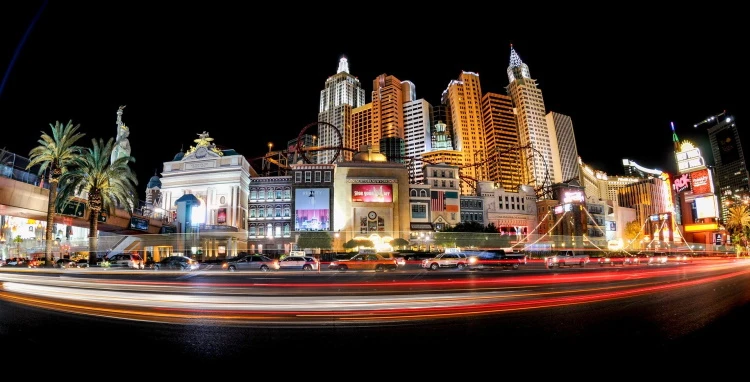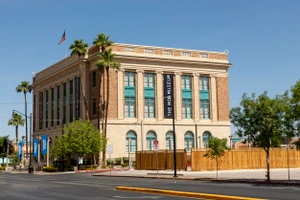The kids are all right: Why families are central to Vegas’ future

As international travel rebounds to Las Vegas following the pandemic, families continue to make up a sizeable chunk of visitors as the city furthers its evolution beyond the gaming capital of the world.
Prior to Covid, Las Vegas reported only 5% of its visitors were parents with children in 2019. A jump to 21% in 2021 was initially explained away as a blip, attributed to virtual classrooms and remote work.
Recent figures suggest that new demographic is here to stay. The Las Vegas Convention and Visitors Authority (LVCVA) recently released its annual survey of visitors that shows that families made up 16% of visitors, the same as in 2022.
What was thought to be a fluke has now become a trend that shows no signs of going away. With Las Vegas doubling down on sporting events and other entertainment experiences, there’s more than ever for families. Even LVCVA officials admitted this was a surprise; it’s now monitoring the family percentage to see if they need to adjust their marketing.
Getting rid of “what happens in Vegas, stays in Vegas”
“The city has worked tirelessly and spent a lot of money to shed itself of the ‘what happens in Vegas, stays in Vegas’ mantra,” says Corey Padveen, a partner with t2 Marketing International. He’s tracked the family trend and is not surprised by it.
“They made huge investments in turning the space between the Strip and downtown into the Arts District. You’ve had the cleanup and revitalisation downtown and adding more events and activities and attractions like the Mob Museum. They’re showing Vegas is a lot more than gambling and partying.”

Padveen believes the 16% figure is close to what its median will be. There’s room for growth up to 25%, which he argues is great for a city “notoriously known as family-adverse for the better part of the last century”.
“I don’t think we should at any point pretend that Vegas is going to be a family destination,” Padveen continues, noting no families were visiting the city 20 years ago.
“But it has the opportunity to attract more families. With the Grand Canyon, Hoover Dam, Death Valley and other areas that Vegas is a jumping off place for, it’s become not only a destination but a hub. You have a huge opportunity to increase that family draw for a stay.”
There’s been “huge leaps and bounds” in terms of family attractions and investments to have made that happen, Padveen explains. One lure for this group is the more affordable downtown experience.
Does Vegas know how to cater to families?
This influx of families is down to Vegas moving towards greater entertainment and sports offerings says Oliver Lovat of Denstone Group.
“We saw the jump in percentage post-Covid and, then when the numbers went up to 40 million (overall visitors) a year in 2023, people are still bringing their families. It’s been in single digits for as long as I can remember.”
Lovat believes 6.5 million family visitors is a robust figure, especially as a combination of domestic and international visitors.
It remains to be seen whether resorts operators know how to engage this group. That 6.5 million figure is comparable to convention visitors and there’s a lot of money spent attracting this audience to the city Lovat says. International visitors are underserved in comparison, when it comes to investments by operators, he adds.
“People are no longer saying it’s a place where gambling stigmatised with casinos all over the country,” Lovat says. “Las Vegas has always been for people in their late 30s to mid-50s. The baby boomers who were coming in the 1990s started to bring their kids and operators started developing for that (in what was a short-lived experiment at the time).
“Now, Gen Xers are coming and bringing their kids.”
The city’s casinos have previously made attempts to soften its image, with little success. Among its experiments was the MGM Grand Adventures Theme Park. That opened in 1993, but closed seven years later.
Las Vegas as a cultural hub
What is working is the cultural and sporting amenities springing up across the city.
The continued influx of families comes as international visitors to Las Vegas increased 39% in 2023, bolstered by gains in tourists from Canada, UK, Germany and Australia.
There were just shy of five million foreign visitors that made up nearly 12% of the 40.8 million visitors in 2023.
“International visitors are bringing their families to Vegas because there’s much more to do other than gambling,” Lovat says. “Whether you’re from Canada, Mexico, the UK or Australia, it’s clear that the range of offerings you have in the market are unlike anywhere else in the world.
“You had the opening of The Sphere and Formula One race in 2023. You have the Raiders and soccer making Las Vegas more visible to international visitors.

“Look at who the musical headliners are. There’s U2, Adele and Kylie Minogue and you had Taylor Swift and BTS, the Korean boy band,” he continues. “It’s more special to see a performer play in Las Vegas than in your home market. That used to be true just in the US, but it’s much more international now.”
Padveen argues that Las Vegas has the potential to be a cultural hub similar to international families visiting New York. By the direction it’s moving, Las Vegas is trying to turn itself into a locale for international family vacations.
Gambling no longer driving growth
Gambling is no longer the driving force for casino revenues in Las Vegas. It made up two-thirds of revenue from the Strip 45 years ago, but that figure is rapidly declining.
A recent Nevada Gaming Control Board showed room, food, beverage and other departments accounted for a record 73.4% of revenue in the 2023 fiscal year, up from a combined 69.6% in 2022. Non-gaming revenues totalled $15bn, representing a new all-time record and an increase of $2.3bn, or 17.7%, versus fiscal-year 2022.

In 1993, visitors spent about five hours a day gambling. In 2023, that was down to two and a half hours even though visitors budgeted a record $788 for their trips, up from $591 before the pandemic.
In 1993, it was $445 but when adjusted for inflation was $945, even higher than today.
The survey continues to show a generational shift in how consumers are spending that bodes well for the Las Vegas economy because it’s a less one-dimensional offering, Padveen says.
“The numbers for gaming are at record highs but make up less than one third of the economy,” Padveen explains. “Las Vegas is in a much better position now since the offerings are so much broader and that appeals to a lot more people even though the gaming percentage is lower than you thought it would be considering how big an economy gaming is there. It’s become more of a traditional economy with a very unique hook, which is that gaming component. That’s a great thing for the city.”
How many families are enough?
The challenge for resort operators going forward is determining what level of visitation from families is enough to make it a market segment worth developing and programming for, Lovat says.
A lot of attractions are outside casinos for now.
Area15 in the resort corridor is a family destination with its experiential attractions, with plans to open a horror experience operated by Universal Parks & Resorts.
Downtown Las Vegas has long been an attraction for families with its museums and other experiences.

“Others like Area15 have taken full advantage of creating entertainment programming where the casinos have been slow on it,” Lovat points out. “They have been letting other people capture that revenue by creating attractions for families.”
There’s been some movement, however, on that front. In 2023, MGM Resorts International opened Project 63 in front of the Aria Resort & Casinos. It’s a four-storey mall that includes museums with interactive experiences.
And there are more family offerings in the works.
MLB takes to the plate
Demolition will begin in April on the Tropicana Las Vegas resort to make way for a $1.5bn baseball stadium for the relocation of the Oakland A’s in 2028.
Major League Baseball is the professional sport that attracts the most families and the state of Nevada approved $380m for the project.
The great thing about Las Vegas is that it offers something for everybody no matter your demographic, says Brendan Bussmann, managing director of B Global Advisors. It’s for single people, families, business executives and sports fans.

In March, Las Vegas hosted several college conference basketball tournaments at venues around the city that brought in scores of fans, especially families.
“Sports and entertainment has been a factor in growing family visitation,” Bussmann explains. “Sports are twofold. You have people coming in for a Raiders game or Vegas Golden Knights game and you bring the whole family.
“But we sometimes forget because it’s not on the Strip that there’s a number of soccer, baseball, basketball and tournaments of other sports for high school kids. You are bringing the whole clan and we have hotel rooms for them.
“The image has shifted from the early 2000s when we had the amusement park at MGM, but this is a destination that works for families and everybody else in between.”
Sports spending in Las Vegas
Some 6% of visitors, or about 2.5 million people, attended a sporting event during their Las Vegas visit, up significantly from 4% in 2019 and 2% in 2018. Visitors spent approximately $326 at these events.
Bussmann doesn’t see that 16% figure falling given the sporting events and concerts made possible with the construction of the 65,000-seat Allegiant Stadium that opened in 2020. There’s also the T-Mobile Arena where the NHL’s Golden Knights play, the baseball stadium and even NBA arena to lure an expansion basketball team.
“16% is nothing to sneeze at,” Bussmann says. “That’s a good number.”
Who is the average Vegas visitor?
Among some of the other findings released in its annual survey, Kevin Bagger, vice-president of the LVCVA Research Center, points out Las Vegas visitors have gradually evolved over the last 40 years.
Back then, the average age was 47 – a number that has been consistent over the years – that is now at 43.8 years. This has happened as the percentage of baby boomer visitors has fallen from 30% prior to the pandemic to 14% in 2023.
Ethnic groups are coming to Las Vegas in greater numbers the younger the visitors are, Bagger adds. Some 78% of baby boomers are white compared to 69% of Generation X, 54% of millennials and 45% of Generation Z.
“We are appealing to the evolving demographics in the United States,” Bagger says.
Some 47% of visitors reported a household income greater than $100,000 compared to 28% in 2019. In 2023, 21% of visitors earned $150,000 or more, up from 9% in 2018.
Food and drink spending led the way at $570 in 2023 followed by shopping at $414, local transportation at $238 and sightseeing at $177.
Visitors spent less in 2023 than in 2022 for shows and entertainment at $278, down from $309.
Global economics impacting Vegas visitation
Lovat, a native of Scotland, said the one concern is that the European economies, unlike the US, are in a weaker position.
“They’ve had huge inflation and huge energy price increases in the last 12 months and hopefully when that crisis abates, international visitors to Las Vegas will return,” Lovat says. “Formula One brought a very high-end European demographic and we saw that in the (record) gaming numbers. I think 2024 will be much stronger than 2023.
“More routes will come back this year and Las Vegas has been on everyone’s screens in the last three months of 2023 with The Sphere, U2 and Formula One.”
When they come, they are satisfied with the experience. Of all the visitors to Las Vegas in 2023, international visitors had the highest level of their expectations being met or exceeded at 99%, according to the survey. It was 95% for domestic visitors.
An international audience
Las Vegas attracted 4.74 million foreign visitors in 2023, which made up 11.6% of the city’s 40.8 million visitors last year. There were 3.4 million foreign visitors in 2022.
The return of foreign travellers is one of the last areas of the Las Vegas tourism market yet to recover from pre-pandemic numbers. Travel from outside of North America increased nearly 46%. There were 5.6 million international visitors in 2019.
“International possesses the biggest opportunity for growth for this destination, plain and simple,” Bussmann says. “That’s a positive because it’s a longer length of stay. It’s a higher spend and there’s an opportunity to hit that out of the park.
“We have to continue to improve lift off the existing routes we have and make sure those planes are full.”

Buck Wargo is a Las Vegas-based business and gaming journalist. He’s a former reporter for the Los Angeles Times. He has a degree in Middle Eastern Studies from the University of Texas and worked as a foreign correspondent in the Middle East.
